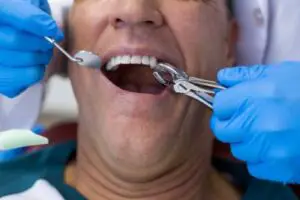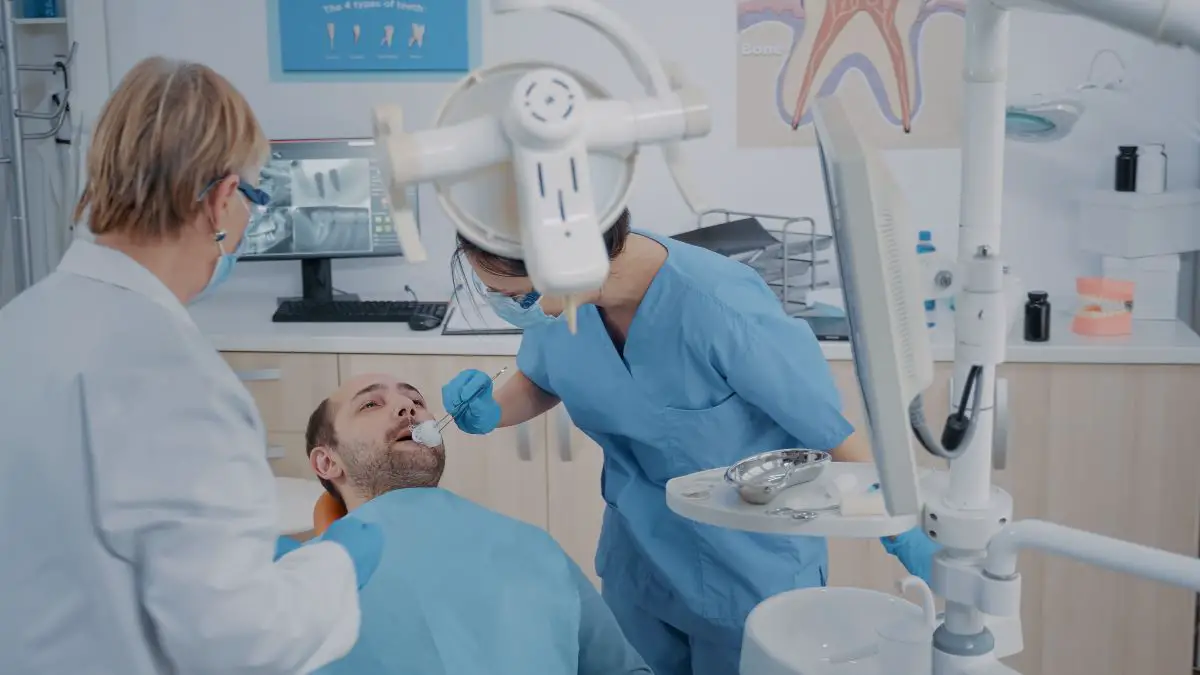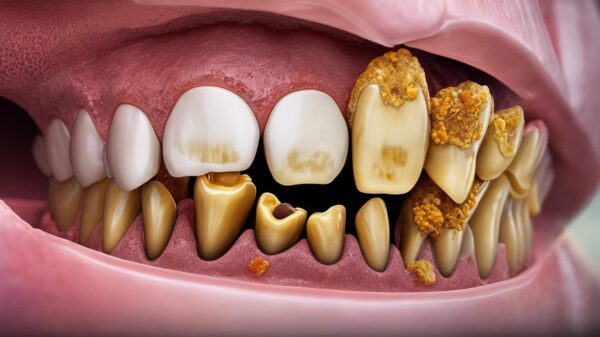The answer to this question depends on several factors, including the type of tooth that was extracted and the person’s overall health. In general, however, it is safe to say that most people will take around one week to fully recover from a tooth extraction. This means that they will be able to eat and drink normally and brush their teeth without any pain or discomfort.
When a tooth that is extracted, it can take anywhere from a few days to a couple of weeks for the extraction site to heal completely. However, if you have a molar (back tooth) extracted, it may take longer for the hole to close up and for your gum tissue to heal than if you have a front tooth pulled. Additionally, if you have had multiple teeth extracted, it will take longer for you to recover than if you have only had one tooth removed. In this article, we will review what a tooth extraction is, why one may need one, the extraction process as well as the length of recovery.
 What is tooth extraction?
What is tooth extraction?
Tooth extraction is a dental procedure that involves the removal of a tooth from its socket in the bone. It is also called tooth pulling or exodontia. The most common reason for tooth extraction is because of decay or infection. Other reasons include crowding of teeth, braces, and trauma.
The first step in tooth extraction is to numb the area with a local anesthetic. The next step is to loosen the tooth by rocking it back and forth. Once the tooth is loose, it is pulled out with forceps. There may be some bleeding after the procedure, which can be controlled with gauze. It is important to keep the area clean after tooth extraction to prevent infection.
In general, however, most people report feeling back to their old selves within a week or so after having a tooth extracted. And while the extraction site may still be tender for a few days after that, the pain should be manageable and should gradually lessen as the days go by.
If you have any concerns about your recovery or if you experience any unusual symptoms, be sure to contact your dentist or oral surgeon. They will be able to give you specific instructions on how to care for your mouth and what to do (or not do) to ensure a smooth and speedy recovery. Most people recover from a tooth extraction within a week. However, some people may experience lingering pain and soreness for longer periods. Additionally, people with certain medical conditions may be at risk for complications and take longer to heal. If you are concerned about your recovery time, talk to your dentist or oral surgeon.
Need For Extraction
There are a few reasons why you might need to have a tooth extracted. If you have a tooth that is severely decayed or damaged, it may need to be removed. Additionally, if you have a tooth that is impacting another tooth (meaning it is growing at an angle), it may also need to be extracted.
- If you have a tooth that is causing you pain or is otherwise bothering you, it is important to talk to your dentist about whether or not an extraction is the best option. In some cases, a simple filling or other procedure may be all that is needed to fix the problem. However, in other cases, an extraction may be the best option to protect your oral health.
- If you do need to have a tooth extracted, your dentist will numb the area around the tooth before performing the procedure. This will help to ensure that you are comfortable during the extraction. Additionally, your dentist may use special tools to help loosen the tooth before removing it. In some cases, a surgical extraction may be necessary, which is a more complex procedure.
- After your tooth has been extracted, it is important to take care of the extraction site. Your dentist will give you specific instructions on how to do this. In general, you will need to avoid chewing on that side of your mouth and brush and floss carefully around the extraction site. You may also need to use a special mouthwash.
It is generally recommended that patients wait until they are at least 18 years old before considering tooth extraction. However, there are some cases where younger patients may need to have a tooth extracted. If your child has a lot of cavities, is experiencing pain, or has an infection, dentists may recommend extraction. They will always try to save the tooth if possible, but in some cases, extraction may be the best option. If you are an adult and considering tooth extraction, there are a few things you should know. First, we will always try to save the tooth if possible. However, if the tooth is too damaged or decayed, extraction may be the only option. In addition, if you are experiencing pain or have an infection, extraction may be necessary.
 Recovery
Recovery
There are a few things you can do to help ensure a speedy recovery following tooth extraction:
- Apply ice to the area for 20 minutes at a time
- Rest and avoid strenuous activity
- Bite on the gauze your dentist gave you to help stop the bleeding
- Restrict your diet to soft foods
- Rinse your mouth with warm salt water several times a day. This will help keep the area clean and reduce swelling
- Drink plenty of fluids and avoid hot drinks or alcohol.
- Avoid drinking from a straw for at least 24 hours. This could dislodge the blood clot and delay healing
- Eat soft foods for the first few days. Avoid hard, crunchy, or sticky foods that could irritate the extraction site
- Brush your teeth carefully, avoiding the extraction area
- Avoid smoking or using tobacco products, as this can delay healing and increase the risk of infection
- Take pain medication as prescribed by your dentist. Over-the-counter medication may be sufficient, but prescription-strength medication may be necessary if the extraction was complicated
The first 24 hours after your tooth is extracted are the most important in terms of preventing complications. During this time, you should: Take it easy for the rest of the day. Avoid strenuous activity and get plenty of rest. This will help your body heal and reduce the risk of bleeding.
Follow your dentist’s instructions for caring for the extraction site. This may involve using a special mouthwash or brushing and flossing carefully around the area. If you experience any severe pain, swelling, or bleeding, be sure to contact your dentist or oral surgeon immediately.
Extraction Process
The first step in the tooth extraction process is to numb the area around the tooth using a local anesthetic. This numbs the nerves and helps to prevent pain during the procedure.
Next, your dentist will make an incision in the gum tissue surrounding the tooth. This exposes the bone and root of the tooth.
Your dentist will then use a tool called an elevator to loosen the tooth and break it up into smaller pieces. This makes it easier to remove the tooth.
Once the tooth has been removed, your dentist will suture (stitch) the gums back together.
You may experience some discomfort and swelling after the procedure, but this can be alleviated with pain medication. It is important to follow your dentist’s instructions for caring for the extraction site.
Finally, your dentist will remove the tooth and any fragments using forceps. The incision in the gum tissue will be closed with stitches.
You can expect some soreness and swelling after the procedure, but this can be treated with pain medication. It is important to follow your dentist’s instructions for caring for the extraction site. However, it is important to note that there may be some bleeding and swelling for the first few days after the extraction. Additionally, the person may experience some bruising around the extraction site. These are all perfectly normal side effects and should not cause any alarm. If the bleeding or swelling persists for more than a few days, or if the person experiences severe pain, then it is advisable to contact a dentist or medical professional.
In most cases, the entire tooth extraction process takes about 30 minutes. However, if you are having multiple teeth extracted, the procedure may take longer.
- Infection is always a risk with any type of surgery, and tooth extractions are no exception. Be sure to follow your dentist’s instructions for care after the procedure to reduce your risk of developing an infection.
- Nerve damage: In rare cases, nerve damage can occur during a tooth extraction. This can lead to numbness or tingling in the lips, tongue, or cheek. If you experience any of these symptoms after a tooth extraction, contact your dentist immediately.
 Summary
Summary
The length of time it takes to recover from a tooth extraction will vary depending on the individual. Some people may feel better in just a few days, while others may experience discomfort for up to a week or more. The type of extraction also plays a role in the recovery time, with simple extractions generally taking less time to heal than more complicated ones. Recovery times can also be affected by other factors, such as the overall health of the individual, whether they smoke, and how well they follow post-operative care instructions.
If you are having a tooth extracted, be sure to follow your dentist’s or oral surgeon’s post-operative care instructions carefully. This will help ensure that you heal quickly and without complication.
– the article is sponsored by Magnolia Dental












